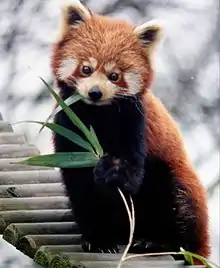| Eaglenest Wildlife Sanctuary | |
|---|---|
IUCN category IV (habitat/species management area) | |
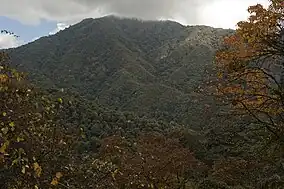 View of Eaglenest forest canopy | |
 | |
| Location | West Kameng, Arunachal Pradesh, India |
| Coordinates | 27°06′0″N 92°24′0″E / 27.10000°N 92.40000°E |
| Area | 218 square kilometres (84 sq mi) |
| Established | 1989 |
| Visitors | 75 (in 2006) |
| Governing body | Government of Arunachal Pradesh |
Eaglenest or Eagle's Nest Wildlife Sanctuary is a protected area of India in the Himalayan foothills of West Kameng District, Arunachal Pradesh. It conjoins Sessa Orchid Sanctuary to the northeast and Pakhui Tiger Reserve across the Kameng river to the east. Altitude ranges are extreme: from 500 metres (1,640 ft) to 3,250 metres (10,663 ft).[1] It is a part of the Kameng Elephant Reserve.
Eaglenest is notable as a prime birding site due to the extraordinary variety, numbers and accessibility of species.
Eaglenest derives its name from Red Eagle Division of the Indian army which was posted in the area in the 1950s.[2]
Geography and climate
Eaglenest and Sessa Orchid Sanctuary together occupy a rough east–west rectangle with Sessa occupying the northeast quadrant. Eaglenest is bounded to the north by Eaglenest Ridge and the reserved forests of the Bugun community (Lama Camp area). Eaglenest adjoins Tawang district to the north. The Bhalukpong–Bomdila highway (and Pakke immediately beyond) are its eastern boundary. There are no distinct geographical features delineating its western boundary along the Bhutan border and the southern boundary at about 27° N latitude.
Eaglenest and Sessa ridges rise to 3,250 metres (10,663 ft) and 3,150 metres (10,335 ft) respectively and are the first major barriers to the monsoon as it moves north from the plains of Assam. These ridges get over 3,000 millimetres (120 in) of rain on the southern slopes and about 1,500 millimetres (59 in) on the northern ones.[3]
The eastern half of Eaglenest and Sessa sanctuaries is drained by the Tippi Naala (Tippi river) which joins the Kameng river at Tippi village on the Bhalukpong–Bomdila highway. Several smaller streams including Buhiri Nadi and Dihung Nadi in the western half of the area flow down to join the Brahmaputra separately.[4][5]
Eaglenest Wildlife Sanctuary is part of the Kameng protected area complex (KPAC), the largest contiguous closed-canopy forest tract of Arunachal Pradesh, which includes Eaglenest, Pakke, Sessa, Nameri, and Sonai Rupai sanctuaries and associated reserved forest blocks. The complex covers 3500 km2 in area and ranges from 100 metres (328 ft) to 3,300 metres (10,827 ft) in altitude.
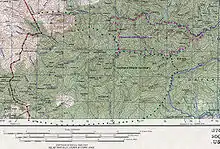
and Sessa Sanctuaries
Eaglenest has an unpaved road running from its base to Eaglenest pass at 2,800 metres (9,186 ft) allowing good access to the entire altitudinal range, making it accessible to the military, scientists and ecotourists.[6]
Fauna

Birds
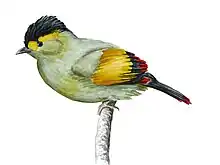
Eaglenest Wildlife Sanctuary is well known as a major birding area.[3] It is home to at least 454 species of birds including 3 cormorants, 5 herons, black stork, Oriental white (black-headed) ibis, 4 ducks, 20 hawks, eagles, kites, harriers and vultures, 3 falcons, 10 pheasants, junglefowl, quail, and peafowl, black-necked crane, 3 rails, 6 plovers, dotterels, and lapwings, 7 waders, ibisbill, Indian Thick-knee, small pratincole, 2 gulls, 14 pigeons, 3 parrots, 15 cuckoos, 10 owls, 2 nightjars, 4 swifts, 2 trogons, 7 kingfishers, 2 bee-eaters, 2 rollers, hoopoes, 4 hornbills, 6 barbets, 14 woodpeckers, 2 broadbills, 2 pittas, 2 larks, 6 martins, 7 wagtails, 9 shrikes, 9 bulbuls, 4 fairy-bluebirds, 3 shrike, brown dipper, 3 accentors, 46 thrushes, 65 Old World flycatchers, 6 parrotbills, 31 warblers, 25 flycatchers, 10 tits, 5 nuthatches, 3 treecreepers, 5 flowerpeckers, 8 sunbirds, Indian white-eye, 3 bunting, 14 finches, 2 munia, 3 sparrows, 5 starlings, 2 orioles, 7 drongos, ashy woodswallow and 9 jays.[7] The sanctuary has the distinction of having three tragopan species, perhaps unique in India.[8]
Eaglenest is the site where Bugun liocichla was first discovered in 1995 and again observed and described in 2006 by Ramana Athreya.[9]

Herpetofauna
Eaglenest Wildlife Sanctuary is home to a wide variety of herpetofauna including at least 34 species of amphibians, 24 species of snakes and 7 species of lizards including 3 geckos, 3 agamids and 4 skinks. Abor Hills agama was rediscovered at Eaglenest after 125 years. Other rare species include the Darjeeling false-wolfsnake which was only known to science through five specimens, Anderson's mountain lizard, Günther's kukri snake, common slug snake, and keelback snakes which have not been definitively identified.[10]
Mammals
Eaglenest Wildlife Sanctuary provides habitat to clouded leopard, marbled cat, Asian golden cat and leopard cat.[11] Other mammal species include the endangered capped langur, red panda, Asiatic black bear and the vulnerable Arunachal macaque and gaur. It was here that a new taxon of primate was discovered in 1997 by noted primatologist of northeast India Dr Anwaruddin Choudhury,[12] but he thought it to be a new subspecies of Tibetan or Pere David's macaque.[13] It was described as a new species, i.e., Arunachal macaque in 2004.[14] The highest elevation (11,000 ft) that the wild Asian elephants reach anywhere is partly in this sanctuary.[15]
Butterflies
Eaglenest Wildlife Sanctuary is home to at least 165 species of butterflies including Bhutan glory, grey admiral, scarce red-forester, dusky labyrinth, tigerbrown, jungle-queen sp, white-edged bushbrown, and white owl.[16]
Flora
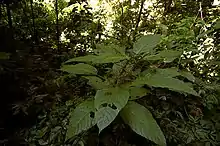
In Eaglenest Wildlife Sanctuary there is a camp named Sessni which in Nepali language means nettle. The place is filled with poisonous elephant nettles on either side of the road.[17]
Conservation
Eaglenest Wildlife Sanctuary is physically protected from timber and animal poaching only by its isolation and the poor quality of the one lane road leading inside it. It is administered by the Divisional Forest Officer, Shergaon Forest Division, Rupa (Millo Tasser, IFS). He is assisted by a Range Forest Office in Singchung and Beat Forest Offices in Ramalingam (close to Singchung) and Khellong. The absence of any settlement inside Eaglenest has minimized any problem of hunting.
The Critical Ecosystem Partnership Fund (CEPF), a consortium of major international and regional organizations, has identified the Eastern Himalayan region around Arunachal Pradesh (Nepal, Bhutan and all of Northeast India) as a critical global biodiversity rich area deserving of conservation focus. They identified the North Bank Landscape (i.e., north bank of Brahmaputra, extending up the Eaglenest slopes) and the Tawang region as worthy of particular focus.[18]
Eaglenest Wildlife Sanctuary is in the Conservation International Himalaya Biodiversity Hotspot area.[19]
BirdLife International has designated Eaglenest and Sessa sanctuaries as an Important Bird Area (IBA IN344), with Blyth's tragopan identified as a vulnerable species of the area.[20]
This area is extremely important for the continued well-being of the Asian elephant. Elephants regularly move up from the Assam plains to the Eaglenest ridge at 3250 m in summer, perhaps the highest altitude that elephants reach in India. Extensive clearing of forests through illegal encroachments in Assam adjacent to Eaglenest has exacerbated elephant-human conflict in the plains; it has also meant that elephants now have to stay longer in the Eaglenest area and may lead to depletion of their food resource by exceeding the rate of regeneration.
References
- ↑ See Map 1 Archived 2007-09-18 at the Wayback Machine, Topo map
- ↑ Athreya Ramana (3/13/2005) Kaati Trust, Pune Eaglenest Wildlife Sanctuary Archived 2007-09-18 at the Wayback Machine
- 1 2 Choudhury A.U. (2003). Birds of Eaglenest Wildlife Sanctuary and Sessa Orchid Sanctuary, Arunachal Pradesh, India. Forktail 19:1-13
- ↑ Topographic map
- ↑ Army Map Service, Corps of Engineers (1955) Series U502, Sheet NG-46-2, Towang, India; Bhutan; China, topographic map 1:250,000, retrieved 10/2/2007 Topographic map
- ↑ Official website of West Kameng District (6/21/2007) Geography Archived 2007-11-02 at the Wayback Machine
- ↑ Athreya Ramana (4/13/2005) Birds of W. Arunachal Pradesh, Checklist, Kaati Trust, Pune Eaglenest record (E) Archived 2007-08-08 at the Wayback Machine
- ↑ Choudhury, A.U. (2005). Distribution, status and conservation of galliformes in north-east India. Pp. 38-56 in: Fuller, R.A. & Browne, S.J. (eds) 2005. Galliformes 2004. Proceedings of the 3rd International Galliformes Symposium. World Pheasant Association, Fordingbridge, UK.
- ↑ Athreya, R. (9/8/2006) A new species of Liocichla (Aves: Timaliidae) from Eaglenest Wildlife Sanctuary, Arunachal Pradesh, India Indian Birds 2 (4): p82-94
- ↑ "Birding Hotspots of W. Arunachal Pradesh". www.aoc.nrao.edu. Retrieved 27 February 2023.
- ↑ Mukherjee. S.; Choudhary, P.; Athreya, R.; Karunakaran, P. V. (2018). Appel, A.; Mukherjee, S.; Cheyne, S. M. (eds.). "A tale of tails – an attempt to decipher small cat distributions by tail lengths". Small Wild Cat Conservation News (Special Issue 1): 11–12.
- ↑ Choudhury, Anwaruddin (2004). "The mystery macaques of Arunachal Pradesh". Rhino Foundation Newsletter. 6: 21–25.
- ↑ "Père David's macaque". Encyclopædia Britannica.
- ↑ Sinha, A., Datta, A., Madhusudan, M. D. and Mishra, C. (2005). "Macaca munzala: a new species from western Arunachal Pradesh, northeastern India". International Journal of Primatology. 26 (977): 977–989. CiteSeerX 10.1.1.576.1210. doi:10.1007/s10764-005-5333-3. S2CID 20459400.
{{cite journal}}: CS1 maint: multiple names: authors list (link) - ↑ Choudhury, A.U. (1999). Status and Conservation of the Asian elephant Elephas maximus in north-eastern India. Mammal Review 29(3): 141-173.
- ↑ Athreya, R. (2006) Eaglenest Biodiversity Project − I (2003–2006): A report submitted to the Forest Department of the Government of Arunachal Pradesh, India, and the Rufford-Maurice-Laing Foundation (UK). Kaati Trust, Pune. Conservation resources for Eaglenest wildlife sanctuary.
- ↑ In search of the Bugun Liocichla and other parables from Eaglenest, archived from the original on 4 February 2012
- ↑ Critical Ecosystem Partnership Fund, Project database Eastern Himalayas Region Strategic Directions Archived 2007-11-08 at the Wayback Machine
- ↑ Conservation International (2007) Himalaya - conservation action and protected areas, retrieved 10/1/2007 Himalaya - conservation action and protected areas Archived 2007-11-09 at the Wayback Machine
- ↑ BirdLife International (2006) BirdLife IBA Factsheet, retrieved 10/1/2007 IN344 Eaglenest and Sessa Sanctuaries
Further reading
External sources
- Snakes of Eaglenest Wildlife Sanctuary - Photo Gallery
- Pictures from Eaglenest Wildlife Sanctuary - Wildlife Photographs
